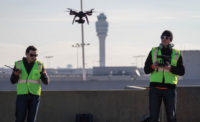The U.S. Dept. of Transportation on Jan.14 issued a notice for proposed rulemaking that would allow drone operators to fly at night and over humans without first obtaining a waiver.
If enacted, the regulation would mean new work for U.S.-based drone companies, with the Federal Aviation Administration also announcing three drone traffic management test sites.
The FAA proposal is open for public comment until March 14.
The proposed rulemaking follows similar ratified drone regulations in Canada, says Michael Cohen, CEO of Industrial Skyworks, the first drone company to obtain a waiver to fly at night in the U.S.
“I think there’s a large chance these proposals will be enacted,” he says. “The Canadian rules were progressive. I think the language in the DOT’s announcement means they’re trying to stay ahead of Canada.”
Night drone flights without waivers—which are currently rarely awarded—means that Cohen and other drone surveyors could perform thermal imaging surveys on buildings that were previously out of their purview.
“Up to today, any major urban center with an airport was not our business,” he says. Nighttime waivers aren’t currently available in those areas. But if the proposal becomes regulation, Cohen says he can market his company’s services in urban centers.
The proposal to allow flight over humans would work in conjunction with nighttime flight for many companies;
Even with a waiver to fly at night near airports, if a company did not have permission to fly over people, it would still be precluded from flying over many building locations.
One professional drone pilot says the regulatory change is sorely needed.
"Tons of people have been [flying over humans and at night] illegally for some time now with little to no repercussions from the FAA," says Lloyd Garden, owner and operator of Drone Promotions. "Meanwhile licensed pilots like myself have had to lose jobs as we would not break the law and risk losing our license."
He adds that it was next to impossible to obtain waivers for over-people flights and very hard for an those at night.
The new regulations would work in tandem with the FAA’s Low Altitude Authorization and Notification Capability, an automated process that lets drone operators enter their locations into an agency app and receive near-instant approval or denial to fly in that airspace.
“The old system was a burdensome online app,” says Cohen. “If the new proposed rulemaking goes through, the whole world opens up in terms of commercial operations.”
Equally important to the integration of drones into the public airspace are the Unmanned Traffic Management Pilot Projects, aimed at developing an automated communications system between drones to avoid striking one another.
State programs selected to take part in the pilot project are Nevada’s UAS Test Site Smart Silver State, North Dakota’s Northern Plains Unmanned Aircraft Systems Test Site and Virginia Tech’s Mid-Atlantic Aviation Partnership, according to the Jan. 14 DOT announcement.
The projects are to run simultaneously until September, according to the announcement.
Chris Theisen, director of research and development at Northern Planes Test Site says, “All three winning test sites will work on the same goals, but each test site had the ability to propose different additional add-on goals and objectives when they won the RFP.”
Nevada ispecializes in surveillance, remote-sensing operations and flying unmanned vehicles in urban areas beyond visual line-of-sight (BVLOS) for deliveries.
North Dakota is specializing in flying BVLOS and in controlled and uncontrolled airspaces and on the outskirts of cities. Virginia Tech's specialties are communications, BVLOS, operating over people and deliveries.
The original UTM technology was developed by NASA, says Theisen, and the test sites are now working to improve it.
If the UTM pilot programs are successful, it could mean that in the future, drones and manned vessels will share airspace and avoid one another in an automated manner, he says. “That means urban drone operations getting to a point of personal transportation. So, you’re talking about flying cars.”





Post a comment to this article
Report Abusive Comment